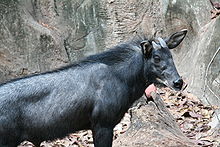Sumatran serow
| Sumatran serow[1] | |
|---|---|
 | |
| A Sumatran serow at Dusit Zoo | |
Conservation status | |
 Vulnerable (IUCN 3.1)[2] | |
| Scientific classification | |
| Domain: | Eukaryota |
| Kingdom: | Animalia |
| Phylum: | Chordata |
| Class: | Mammalia |
| Order: | Artiodactyla |
| Family: | Bovidae |
| Subfamily: | Caprinae |
| Genus: | Capricornis |
| Species: | C. sumatraensis |
| Subspecies: | C. s. sumatraensis |
| Trinomial name | |
| Capricornis sumatraensis sumatraensis (Bechstein, 1799) | |
The Sumatran serow (Capricornis sumatraensis sumatraensis), also known as the southern serow, is a subspecies of the mainland serow native to mountain forests in the Thai-Malay Peninsula and on the Indonesian island of Sumatra.[2] It was previously considered its own species, but is now grouped under the mainland serow (Capricornis sumatraensis), as all the mainland species of serow (Chinese, red and Himalayan) were previously considered subspecies of this species. The Sumatran serow is threatened due to habitat loss and hunting, leading to it being evaluated as vulnerable by the IUCN.[2]
The Sumatran serow (Capricornis sumatraensis) is a species of wild goat-antelope native to the island of Sumatra in Indonesia. This elusive mammal is typically found in mountainous forests and steep terrains, where it can easily navigate rocky landscapes due to its strong hooves and agile nature.[3]
Physical Characteristics
The Sumatran serow has a stocky build, standing about 85-94 cm tall at the shoulder.
It has coarse, dark fur, ranging from black to grayish, which helps it blend into the forest undergrowth.
Both males and females have backward-curving horns, which are relatively short but thick.[4]
Distribution and habitat
The Sumatran serow (Capricornis sumatraensis) is found throughout Southeast Asia, including the island of Sumatra, the Malay Peninsula, southern Thailand, and parts of Myanmar. It inhabits rugged, forested, and mountainous terrains, often in remote and rocky areas. Due to habitat loss and fragmentation, its populations are sparse and scattered, making it a vulnerable species across its range.[5][6]
Behavior and Diet
The serow is primarily a solitary animal, although it may occasionally be seen in small groups.
Its diet consists of grasses, leaves, fruits, and shrubs, making it an herbivore adapted to the varied vegetation found in its habitat.[7]
Threats
The Sumatran serow (Capricornis sumatraensis) faces severe threats from illegal hunting and trade across Southeast Asia, driven by demand for its meat, traditional medicine, and trophies. Poached from remote mountainous regions, its parts are trafficked across borders through organized wildlife networks. Weak enforcement, porous borders, and high demand exacerbate the issue, leading to population declines and biodiversity loss. Efforts to combat this illegal trade include stronger laws, international cooperation, and public awareness campaigns, though challenges persist in effectively curbing this wildlife crime.[8][9]
Conservation Status
The Sumatran serow is classified as Vulnerable by the IUCN due to habitat loss, poaching, and deforestation, which threaten its population. It is also hunted for its meat and traditional medicine use.[10]
Conservation efforts are ongoing, with a focus on protecting its natural habitat in Sumatra's forests and implementing anti-poaching measures.[11]
The Sumatran serow remains one of Southeast Asia's lesser-known, yet fascinating, species that is vital to the biodiversity of the region's ecosystems.[12]
References
- ^ Wilson, D. E.; Reeder, D. M., eds. (2005). Mammal Species of the World: A Taxonomic and Geographic Reference (3rd ed.). Johns Hopkins University Press. ISBN 978-0-8018-8221-0. OCLC 62265494.
- ^ a b c Phan, T.D.; Nijhawan, S.; Li, S. & Xiao, L. (2020). "Capricornis sumatraensis". IUCN Red List of Threatened Species. 2020: e.T162916735A162916910.
- ^ "Capricornis sumatraensis (Sumatran Serow)". Animal Diversity Web. University of Michigan. 2024. Retrieved 30 August 2024.
- ^ "Sumatran Serow". www.thesumatracameratrapproject.com. Retrieved 2024-08-30.
- ^ "Southern Serow - Capricornis sumatraensis". www.ecologyasia.com. Retrieved 2024-08-30.
- ^ Parks, Creative Commons Attribution-ShareAlike 4 0 International Thai National. "Capricornis sumatraensis, Sumatran serow". Thai National Parks. Retrieved 2024-08-30.
{{cite web}}: CS1 maint: numeric names: authors list (link) - ^ "Sumatran Serow". Animalia.bio. Animalia. 2024. Retrieved 30 August 2024.
- ^ "The Role of Traffic in Reducing Wildlife Trafficking in Southeast Asia 2019-2020" (PDF). Atlantis Press. Atlantis Press. 2024. Retrieved 30 August 2024.
- ^ Morse, Ian (2021-03-31). "In Sumatra, a vulnerable, 'mythical' wild goat lives an unknown life". Mongabay Environmental News. Retrieved 2024-08-30.
- ^ "Species: Capricornis sumatraensis". The IUCN Red List of Threatened Species. International Union for Conservation of Nature. 2021. Retrieved 30 August 2024.
- ^ "The Loner of Steep Cliffs". Indonesia.go.id. Government of Indonesia. 2021. Retrieved 30 August 2024.
- ^ "Sumatran Serow (Capricornis sumatraensis) – Ralfs' Wildlife and Wild Places" (in German). Retrieved 2024-09-04.
External links
- SUMATRAN SEROW Capricornis sumatraensis sumatraensis (Bechstein, 1799) Archived 2007-10-10 at the Wayback Machine
- v
- t
- e










